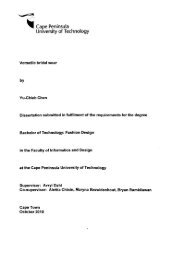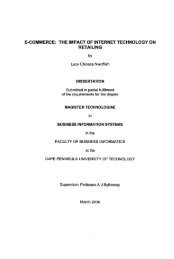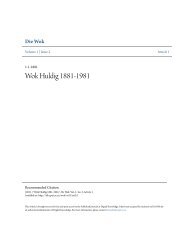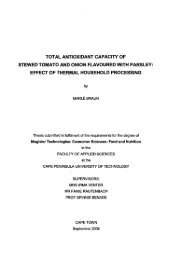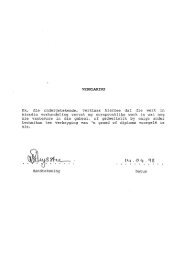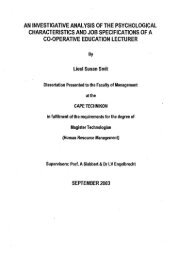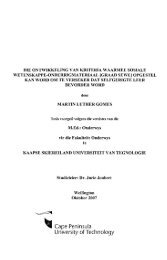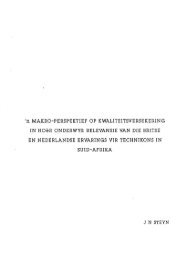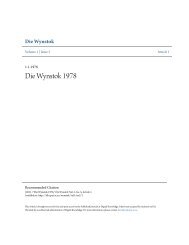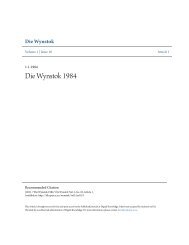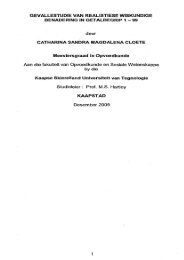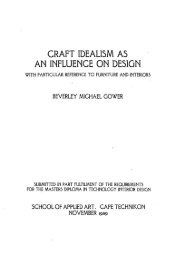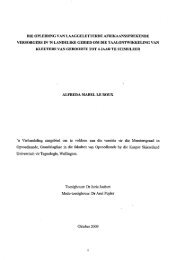the effect of the particle size distribution on non-newtonian turbulent ...
the effect of the particle size distribution on non-newtonian turbulent ...
the effect of the particle size distribution on non-newtonian turbulent ...
Create successful ePaper yourself
Turn your PDF publications into a flip-book with our unique Google optimized e-Paper software.
2.1 INTRODUCTION<br />
CHAPTER 2<br />
LITERATURE REVIEW<br />
The presentati<strong>on</strong> in this chapter deals with <str<strong>on</strong>g>the</str<strong>on</strong>g> rheological fundamentals relevant to fluid flow<br />
in pipes. These fundamentals include <str<strong>on</strong>g>the</str<strong>on</strong>g> classificati<strong>on</strong>, measurement and interpretati<strong>on</strong> <str<strong>on</strong>g>of</str<strong>on</strong>g><br />
n<strong>on</strong>-Newt<strong>on</strong>ian behaviour.<br />
.<br />
2.2 FLOW PATTERNS<br />
The nature <str<strong>on</strong>g>of</str<strong>on</strong>g> flow <str<strong>on</strong>g>of</str<strong>on</strong>g>a fluid depends <strong>on</strong> a number <str<strong>on</strong>g>of</str<strong>on</strong>g> factors. Factors influencing flow are:<br />
• <str<strong>on</strong>g>the</str<strong>on</strong>g> physical properties <str<strong>on</strong>g>of</str<strong>on</strong>g> <str<strong>on</strong>g>the</str<strong>on</strong>g> fluid and its mass flow rate,<br />
• <str<strong>on</strong>g>the</str<strong>on</strong>g> geometry <str<strong>on</strong>g>of</str<strong>on</strong>g> <str<strong>on</strong>g>the</str<strong>on</strong>g> c<strong>on</strong>tainer or pipeline.<br />
The flow <str<strong>on</strong>g>of</str<strong>on</strong>g> a fluid can be characterized into <strong>on</strong>e <str<strong>on</strong>g>of</str<strong>on</strong>g> three categories namely larninar flow,<br />
transiti<strong>on</strong>al flow or <strong>turbulent</strong> flow.<br />
2.2.1 L4uninar Flow<br />
In larninar flow layers <str<strong>on</strong>g>of</str<strong>on</strong>g> fluid move relative to each o<str<strong>on</strong>g>the</str<strong>on</strong>g>r without any macroscopic<br />
intermixing (Holland, 1973) ie. <str<strong>on</strong>g>the</str<strong>on</strong>g>re are no comp<strong>on</strong>ents <str<strong>on</strong>g>of</str<strong>on</strong>g> velocity normal to <str<strong>on</strong>g>the</str<strong>on</strong>g> directi<strong>on</strong><br />
<str<strong>on</strong>g>of</str<strong>on</strong>g> flow (Govier & Aziz, 1972). From <str<strong>on</strong>g>the</str<strong>on</strong>g> above statement it can be understood why laminar<br />
flow is also referred to as viscous or streamline flow in <str<strong>on</strong>g>the</str<strong>on</strong>g> literature.<br />
For <str<strong>on</strong>g>the</str<strong>on</strong>g> purpose <str<strong>on</strong>g>of</str<strong>on</strong>g> this study <str<strong>on</strong>g>the</str<strong>on</strong>g> yield pseudoplastic model has been used for larninar flow<br />
predicti<strong>on</strong>s (secti<strong>on</strong> 2.6), although o<str<strong>on</strong>g>the</str<strong>on</strong>g>r models in <str<strong>on</strong>g>the</str<strong>on</strong>g> literature may also be used.<br />
2.2.2 Transiti<strong>on</strong> from Laminar to Turbulent Flow<br />
There are several methods in <str<strong>on</strong>g>the</str<strong>on</strong>g> literature that can be used to identify <str<strong>on</strong>g>the</str<strong>on</strong>g> transiti<strong>on</strong> between<br />
•



